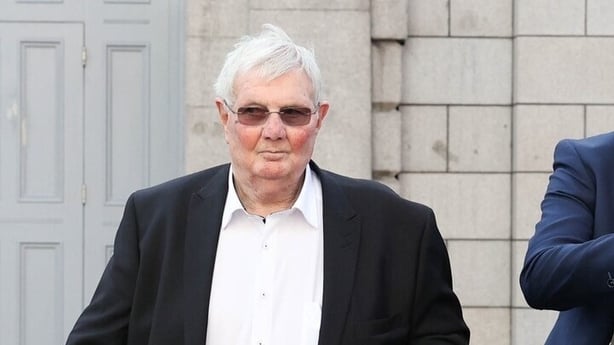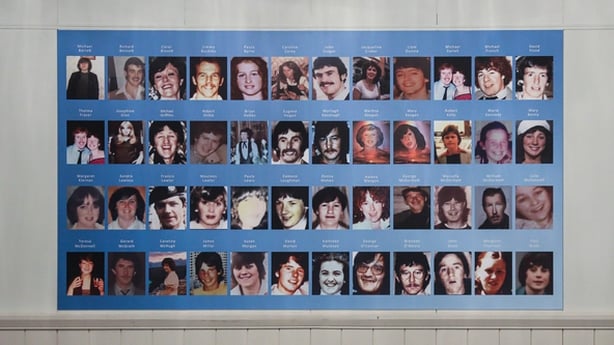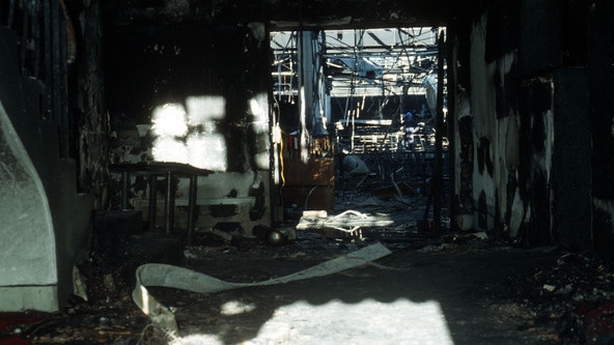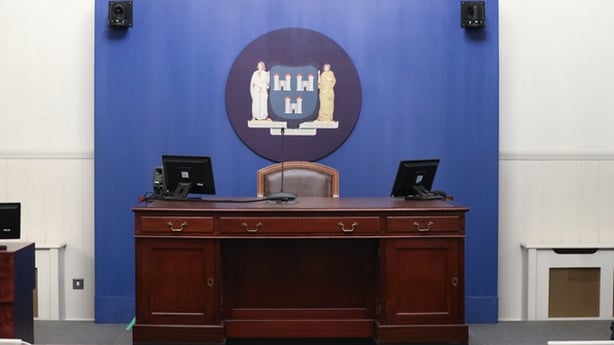He has now spent, in total, around 19 hours giving direct evidence - the longest of any other witness so far at these inquests, and not likely to be surpassed.
Eamon Butterly is widely regarded as the most significant witness so far and will probably remain so.
These inquests, which began in April, have heard from scores of people, and it was Eamon Butterly's appearance that was awaited with particular interest.
In the days before his arrival, there was a sense of anticipation. Relatives of the dead wrote their names on sheets of paper and left them on the seats in the public gallery. They were reserving their places, they didn't want to miss out.
Journalists who had been there in person since the hearings began had words in their ear, "best keep your coat on those seats for next week".
It was just after 10.30am on Thursday 21 September when Eamon Butterly arrived, accompanied by his solicitor. He was dressed in a black suit and a white shirt. To get on to the grounds, he walked past a group of family members of the victims who were standing outside the gates. No words were exchanged.
Many of those there had not seen or heard from him for decades. He has, it seems, largely remained silent, publicly at least, on the events of 42 years ago.
At 11am, proceedings in the Dublin District Coroner’s Court - sitting in the Pillar Room at the Rotunda Hospital - got under way. The coroner Dr Myra Cullinane was at her bench, the jury in their seats, and Eamon Butterly was in the witness box.

Who is Eamon Butterly?
The Butterly name is synonymous with the Stardust nightclub. Eamon Butterly, now 78, was 36 years old in 1981 and was the manager, overseeing the running of the premises which included the nightclub and the adjoining Lantern Rooms and Silver Swan bar.
He had been there too in the late 70s for the conversion of the building from a former food factory into the entertainment venue. It was described at the inquests as probably one of the largest ballrooms in the country at the time, and was owned by a company that was owned by the Butterlys.
The court has heard how it was a family-run business. There have been questions this week and last about the ownership and management of the premises. On numerous occasions, Eamon Butterly said that it was his father who was "the boss". He described himself as the "manager of managers". He has told the inquests too that he was not the owner.
At one point during questioning, Michael O’Higgins SC representing families of the victims, said during the planning permission phase and "before a sod of soil" was turned, the city’s chief fire officer should have been consulted.
During that exchange, Eamon Butterly replied "I wasn’t involved in any of that" adding that his father "was the boss".
His Evidence So Far
The Locking
The inquests have heard repeatedly about the practice of locking exit doors up until around midnight on disco nights while patrons were inside. And it was on this that Eamon Butterly acknowledged that his evidence is "contradictory".
Michael O’Higgins put it to him that in his first day of giving evidence at the inquests, Eamon Butterly said that the practice had come from Tom Kennan, who was the head doorman, and that Eamon Butterly told him to stop doing it.
During sustained questioning on the matter, Mr O'Higgins read from the 1981 Keane Tribunal into the fire and noted that during evidence there, Mr Butterly said that he made the decision himself to introduce the practice of locking the fire exits for a time on disco nights.

Mr O’Higgins put it to the witness that he was either not telling the truth at these fresh inquests or was not telling the truth in 1981. "I was telling the truth all the time, the best I could," replied Mr Butterly.
At one point he said: "It is contradictory all right, yeah". He was also asked why he didn’t include in his original statement to gardaí shortly after the fire, mention of the policy of locking at least three of the exits for a time on disco nights. Counsel for the families suggested that he had omitted it deliberately. Eamon Butterly replied that he had "answered all the questions that were asked of me".
The Night
On numerous occasions, Mr Butterly has repeated that he was told by Tom Kennan on the night in question that all the exits were opened in the club and told the court too that he still believes the doors were unlocked.
He was asked if he was in a position to prove it, to which he replied he was in a position to tell anyone who asked that Tom Kennan told him at 11.30pm that the doors were unlocked.
Counsel for the families have at all times disputed the suggestion that all the doors were unlocked and at one point in the proceedings read into the record numerous accounts of people who struggled to get out the doors. Eamon Butterly later told the court that those accounts were shocking.
The 'Mock-Locking'
The inquests have heard much about the draping of chains over the bars of the exits doors to give the impression they were locked. It’s become known as 'mock-locking’. The court heard how in 1981, Eamon Butterly told the gardaí that the practice had originated from the doormen themselves, and had been in place for around three weeks before the fire.

But the legal teams for the families believe the practice was in place "for years" and pointed to the fact that Eamon Butterly said it at the Keane tribunal. Eamon Butterly this week rejected suggestions that he was misleading the gardaí and trying to minimise the wrongdoing by telling them the practice was in place for weeks not years.
The legal representatives of the families have continually argued that this mock-locking had dire consequences in preventing people making a speedy exit.
The Letter
The inquests also heard how Dublin Corporation wrote to the Stardust three weeks before the fatal fire asking for "immediate assurances" that exits should be "unobstructed" at all times while the public were on the premises.
The letter was addressed to Patrick Butterly and followed a visit to the venue by an inspector on the night of ‘The Specials’ concert held eight days earlier. It was Eamon Butterly who replied and said that he personally was taking "great care" to make sure the exits were clear.
"Again, I assure you that all exits will be kept clear when the public are on the premises," he wrote. Michael O'Higgins, put it to him while Mr Butterly was saying in his letter that "everything was wonderful", he did not include the fact that certain exit doors were being locked on disco nights.
He asked Mr Butterly if this was "misleading". "No," Mr Butterly replied, "I was just answering a letter". Later in the questioning, he said: "I never concealed anything from the authorities".
The Tiles
The use of carpet tiles on the wall of the club has long been the subject of controversy.
As Eamon Butterly was in the witness box, Michael O’Higgins told him and the court there will be evidence from expert witnesses on the matter that the use of the tiles significantly contributed to the fire’s rapid spread and reduced the time available for occupants to escape.
When questioned about the tiles, Eamon Butterly has pointed to Dublin Corporation, and said the tiles were not put up until they got permission from corporation officials. He said that if the corporation had said the tiles would have to be taken down, "you’d take them down".

He also said during the hearings, "we didn’t do anything that didn’t get the go ahead from Dublin Corporation". Dublin Corporation, now Dublin City Council, are present at these inquests. Its legal team is expected to question Eamon Butterly when the inquests resume.
The Testimony
At one point during his direct evidence, speaking about the venue, Eamon Butterly said "we thought it was one of the safest places around". He was asked too this week, if there was anything he would have done differently.
The now 78-year-old replied that he would never have got involved in converting the premises into a nightclub. He said: "I would have knocked it down and built a new one and … do something different with it." "That’s the one thing you’d do differently?" Michael O’Higgins asked. "I would, yeah," replied Mr Butterly.
The Hearings
The proceedings have at times been intense and they can also be complex as documents from four decades ago are read out, including lengthy transcripts from the Keane Tribunal along with garda statements from the time.
It’s been a challenge, sometimes, for the audio-visual team to keep up as the excerpts are displayed on screens. All the while, save for a one-hour lunch break (the inquests usually sit for five hours a day), Eamon Butterly is in his seat in the witness box.
He has a small screen in front of him so he can see the relevant documents being referred to, and has a bigger monitor off to his side. In front of him there’s usually glass of water, but he rarely drinks from it. He uses headphones to help hear the questions, of which there are many.
And there’s more to come. Eamon Butterly is due back on the stand when the inquests resume.






